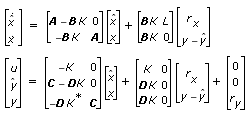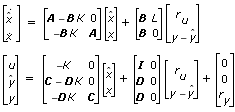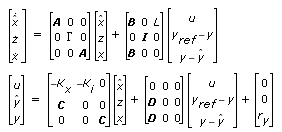Owning Palette: State Feedback Design VIs
Installed With: Control Design and Simulation Module
Builds a state-space controller based on known inputs, manipulated inputs, measured outputs, linear state-space model, estimator gain, and controller gain. You must manually select the polymorphic instance you want to use.
A general system configuration for the state compensator is one where this VI appends the original model states (x) to the estimation model states ( ) to represent the compensator with an estimator, as shown in the following equations.
) to represent the compensator with an estimator, as shown in the following equations.

Use the pull-down menu to select an instance of this VI.
 Place on the block diagram Place on the block diagram |  Find on the Functions palette Find on the Functions palette |
State-Space Controller (Compensator)

 | Configuration specifies if this VI includes the system in the estimator or considers noise as an input of the estimator. The estimator also can be a standalone estimator.
| ||||||
 | Estimator Gain (L) is the gain that premultiplies the output error to correct the model state dynamics towards the physical states of the system. | ||||||
 | State-Space Model contains a mathematical representation of and information about the process that you want to use to build the controller. | ||||||
 | Measured Outputs lists the index numbers of all the outputs that you can measure for state estimation. The index is zero-based. By default, this VI measures all outputs. | ||||||
 | Known Inputs lists the index numbers of all the inputs that are known for state estimation. The index is zero-based. By default, all inputs are known. | ||||||
 | Manipulated Inputs are the inputs that this VI adjusts in the system and uses for control. | ||||||
 | error in describes error conditions that occur before this VI or function runs.
The default is no error. If an error occurred before this VI or function runs, the VI or function passes the error in value to error out. This VI or function runs normally only if no error occurred before this VI or function runs. If an error occurs while this VI or function runs, it runs normally and sets its own error status in error out. Use the Simple Error Handler or General Error Handler VIs to display the description of the error code.
Use exception control to treat what is normally an error as no error or to treat a warning as an error.
Use error in and error out to check errors and to specify execution order by wiring error out from one node to error in of the next node.
| ||||||
 | Controller Gain (K) is the gain that premultiplies the estimated state to calculate the manipulated inputs to drive the system towards or back to a reference. | ||||||
 | Controller Model returns the state-space model for the controller. The inputs, number of states, and outputs are a function of the configuration you select. | ||||||
 | error out contains error information. If error in indicates that an error occurred before this VI or function ran, error out contains the same error information. Otherwise, it describes the error status that this VI or function produces.
Right-click the error out front panel indicator and select Explain Error from the shortcut menu for more information about the error.
|
State-Space Controller (Regulator)
A general system configuration for the state regulator is one where this VI appends the original model states (x) to the estimation model states ( ) to represent the state regulator with an estimator, as shown in the following equations.
) to represent the state regulator with an estimator, as shown in the following equations.


 | Configuration specifies if this VI includes the system in the estimator or considers noise as an input of the estimator. The estimator also can be a standalone estimator.
| ||||||
 | Estimator Gain (L) is the gain that premultiplies the output error to correct the model state dynamics towards the physical states of the system. | ||||||
 | State-Space Model contains a mathematical representation of and information about the process that you want to use to build the controller. | ||||||
 | Measured Outputs lists the index numbers of all the outputs that you can measure for state estimation. The index is zero-based. By default, this VI measures all outputs. | ||||||
 | Known Inputs lists the index numbers of all the inputs that are known for state estimation. The index is zero-based. By default, all inputs are known. | ||||||
 | Manipulated Inputs are the inputs that this VI adjusts in the system and uses for control. | ||||||
 | error in describes error conditions that occur before this VI or function runs.
The default is no error. If an error occurred before this VI or function runs, the VI or function passes the error in value to error out. This VI or function runs normally only if no error occurred before this VI or function runs. If an error occurs while this VI or function runs, it runs normally and sets its own error status in error out. Use the Simple Error Handler or General Error Handler VIs to display the description of the error code.
Use exception control to treat what is normally an error as no error or to treat a warning as an error.
Use error in and error out to check errors and to specify execution order by wiring error out from one node to error in of the next node.
| ||||||
 | Controller Gain (K) is the gain that premultiplies the estimated state to calculate the manipulated inputs to drive the system towards or back to a reference. | ||||||
 | Controller Model returns the state-space model for the controller. The inputs, number of states, and outputs are a function of the configuration you select. | ||||||
 | error out contains error information. If error in indicates that an error occurred before this VI or function ran, error out contains the same error information. Otherwise, it describes the error status that this VI or function produces.
Right-click the error out front panel indicator and select Explain Error from the shortcut menu for more information about the error.
|
State-Space Controller (Regulator with Integral)
A general system configuration for the state regulator with integral action is one where this VI appends the output error integrator (z) to the estimation model states ( ). In addition, this VI augments the resulting vector (
). In addition, this VI augments the resulting vector ( , z) with the original model states (x) to represent the state regulator with integral action and an estimator.
, z) with the original model states (x) to represent the state regulator with integral action and an estimator.


 | Configuration specifies if this VI includes the system in the estimator or considers noise as an input of the estimator. The estimator also can be a standalone estimator.
| ||||||
 | Estimator Gain (L) is the gain that premultiplies the output error to correct the model state dynamics towards the physical states of the system. | ||||||
 | State-Space Model contains a mathematical representation of and information about the process that you want to use to build the controller. | ||||||
 | Measured Outputs lists the index numbers of all the outputs that you can measure for state estimation. The index is zero-based. By default, this VI measures all outputs. | ||||||
 | Known Inputs lists the index numbers of all the inputs that are known for state estimation. The index is zero-based. By default, all inputs are known. | ||||||
 | Manipulated Inputs are the inputs that this VI adjusts in the system and uses for control. | ||||||
 | error in describes error conditions that occur before this VI or function runs.
The default is no error. If an error occurred before this VI or function runs, the VI or function passes the error in value to error out. This VI or function runs normally only if no error occurred before this VI or function runs. If an error occurs while this VI or function runs, it runs normally and sets its own error status in error out. Use the Simple Error Handler or General Error Handler VIs to display the description of the error code.
Use exception control to treat what is normally an error as no error or to treat a warning as an error.
Use error in and error out to check errors and to specify execution order by wiring error out from one node to error in of the next node.
| ||||||
 | Controller Gain (K) is the gain that premultiplies the estimated state to calculate the manipulated inputs to drive the system towards or back to a reference. | ||||||
 | Integral Gain (Ki) is active when this VI independently tunes the integral action from the controller gain K. Integral Gain (Ki) is empty when this VI includes the integral action gain in the controller gain K. | ||||||
 | Controller Model returns the state-space model for the controller. The inputs, number of states, and outputs are a function of the configuration you select. | ||||||
 | error out contains error information. If error in indicates that an error occurred before this VI or function ran, error out contains the same error information. Otherwise, it describes the error status that this VI or function produces.
Right-click the error out front panel indicator and select Explain Error from the shortcut menu for more information about the error.
|
CD State-Space Controller Details
The LabVIEW Control Design and Simulation Module provides three types of state controllers—a compensator, a regulator, and a regulator with integral action. The difference in these controllers is in how you calculate the control action. There are four different configurations to synthesize a state controller. These configurations are system included, system included with noise, standalone with estimator, and standalone without estimator. Both the system included and system included with noise configurations automatically include an estimator in the configuration. The configuration of a controller depends on the inputs.
The system included configuration bases the control action on the estimated states. This VI calculates the states and outputs of the system internally. You do not need to provide the system outputs as the inputs of the estimator to synthesize the controller.
The system included with noise configuration incorporates sensor noise into the system included configuration. Therefore, sensor noise is an input of the controller model. Sensor noise affects the estimated states that you use to calculate the control action.
The standalone with estimator configuration bases the control action on the estimated states using the estimator gain this VI provides. The estimated states are based on the actual outputs of the system. The system outputs are inputs of the standalone controller. This configuration is useful for implementing the estimator on a real-time target.
The standalone without estimator configuration bases the control action on the actual states because it does not require an estimator. This configuration considers a full state feedback structure and the controller internally calculates the system outputs.
Refer to the LabVIEW Control Design User Manual for more information about building a state-space controller.





